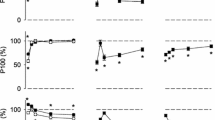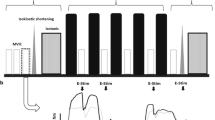Summary
In fourteen subjects we compared maximum voluntary eccentric, concentric, and isometric contractions. The maximum voluntary forces by the subjects on a weight-lifting rod when changing from standing to squatting and from squatting to standing, and during a halfway knee-bend, were measured. The rod was placed on a special stand and moved up and down at a constant speed of 8.5 m/s by a motor. Energy expenditure was measured by the indirect method and EMG activity was measured in the quadriceps femoris. It was found that the force which the muscles generated was greatest during eccentric contraction, lower during isometric and lowest during concentric contraction. Energy expenditure was slightly greater during concentric than eccentric contraction. The level of difference in EMG activity of the quadriceps femoris was statistically insignificant. An energy comparison with isometric contractions was not undertaken in view of the very complex nature of these relationships.
Similar content being viewed by others
References
Asmussen E (1952) Positive and negative muscular work. Acta Physiol Scand 28: 364–382
Asmussen E (1965) Muscular exercise. In: Fenn WO, Rahn H (eds) Handbook of physiology-respiration, vol. II. Williams & Wilkins, New York, pp 939–978
Asmussen E, Hansen O, Lammert O (1965) The relation between isometric and dynamic muscle strength in man. Comm Dan Natl Assoc 20: 3–11
Bethe A (1929) Aktive und passive Kraft menschlicher Muskeln. Pfluegers Arch 222: 334–349
Dijk JHM (1978) Simulation of human arm movements controlled by peripheral feedback. Biol Cybern 29: 175–186
Doss WS, Karpovich PV (1965) A comparison of concentric, eccentric, and isometric strength of elbow flexors. J Appl Physiol 20: 351–353
Hesser CM (1965) Energy cost of alternating positive and negative work. Acta Physiol Scand 63: 84–93
Hill AV (1938) The heat of shortening and the dynamic constants of muscle. Proc R Soc Lond [Biol] 126: 136–195
Hill AV (1949) The heat of activation and the heat of shortening in a muscle twitch. Proc R Soc Lond [Biol] 136: 195–211
Hollman W, Hettinger T (1969) Das excentrische Krafttraining und sein Einflu\ auf die Muskelkraft. Sportarzt Sportmed 9: 343–346
Johnson BL (1972) Eccentric vs concentric muscle training for strength development. Med Sci Sports 4: 111–115
Jörgensen K (1976) Force-velocity relationship in human elbow flexors and extensors. In: Komi PV (ed) International series on biomechanics, vol 1A: Biomechanics V+A. University Park Press, Baltimore London Tokyo, pp 145–151
Komi PV (1969) Effect of eccentric and concentric muscle conditioning on tension and elektrical activity of human muscle. Masters thesis. Pennsylvania State University
Komi VP (1972) Measurement of the force-velocity relationship in human muscle under concentric and eccentric contractions. Masters thesis. University of JyvÄskylÄ, JyvÄskylÄ
Komi PV (1973) Relationship between muscle tension, EMG, and velocity of contraction under concentric and eccentric work. In: Desmedt IE (ed) New development in electromyography and clinical neurophysiology, vol 1. Karger, Basel, pp 596–606
Komi PV, Rusko H (1974) Quantitative evaluation of mechanical and electrical changes during fatigue loading of eccentric and concentric work. Scand J Rehabil Med [Suppl] 3: 121–126
Logan GA (1952) Comparative gains in strength resulting from eccentric and concentric muscular contraction. Masters thesis. University of Illinois, Urbana
Margaria R (1968) Positive and negative work performances and their effeciencies in human locomotion. Int Z Angew Physiol Einschl Arbeitsphysiol 25: 339–351
Matsui H, Miyashita M, Mochioshi M, Hoskikava T (1970) The elctromyografic study of positive and negative work. In: Copies of our researches 1960–1970, University Press, Nagoya, pp 36–40
Müller EA (1953) Energieumsatz und Pulsfrequenz bei negativer Muskelarbeit. Int Z Angew Physiol Einschl Arbeitsphysiol 15: 196–200
Petersen FB (1960) Muscle training by static concentric and eccentric contractions. Acta Physiol Scand 48: 406–416
Rasch PJ, Pierson W (1960) Relationship between maximum isometric tension and breaking strength of forearm flexors. Res Q 31: 534–535
Rodgers KL, Berger RA (1974) Motor-unit involvement and tension during maximum, voluntary concentric, eccentric and isometric contractions of the elbow flexors. Med Sci Sports 6: 253–259
Seliger V (1967) Energetic metabolism in selected physical exercises (in Czech). Universita Karlova, Praha
Seliger V, Dolejš L, Karas V, Pachlopníková I (1968) Adaption of trained athletes energy expenditure to repeated concentric and eccentric muscle contractions. Int Z Angew Physiol Einschl Arbeitsphysiol 26: 227–234
Singh M, Karpovich PV (1967) Effect of eccentric training of agonists on antagonists muscles. J Appl Physiol 23: 742–745
Talag TS (1973) Residual muscular soreness as influenced by concentric, eccentric and static contractions. Res Q Am Assoc Health Phys Educ 44: 458–469
Zacharjanc JZ (1965) EMG charakteristic eccentric contractions of muscles under physical exercises (in Russian) In: Materialy sedmoj naučnoj konferencii po voprosam fiziologii, morfologii i biochimii dvigatelnoj dejatelnosti. Fizk i sport, Moscow, pp 115–118
Author information
Authors and Affiliations
Rights and permissions
About this article
Cite this article
Seliger, V., Dolejš, L. & Karas, V. A dynamometric comparison of maximum eccentric, concentric, and isometric contractions using EMG and energy expenditure measurements. Europ. J. Appl. Physiol. 45, 235–244 (1980). https://doi.org/10.1007/BF00421331
Accepted:
Issue Date:
DOI: https://doi.org/10.1007/BF00421331




